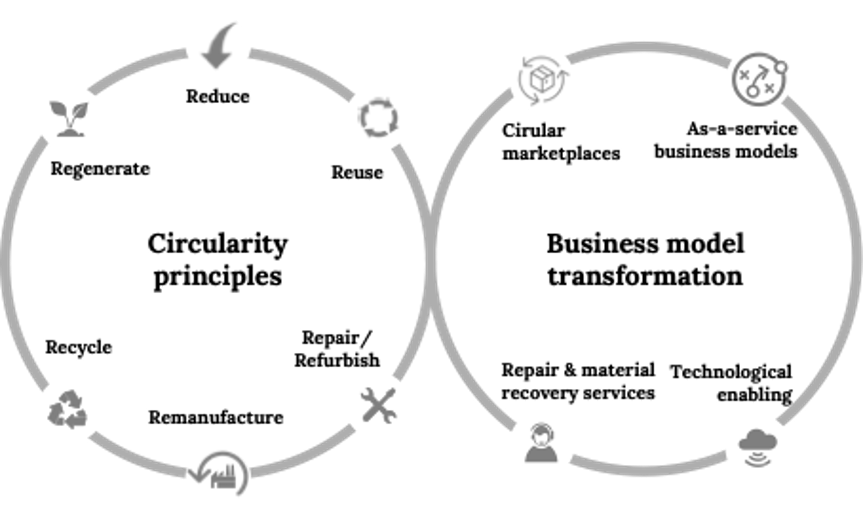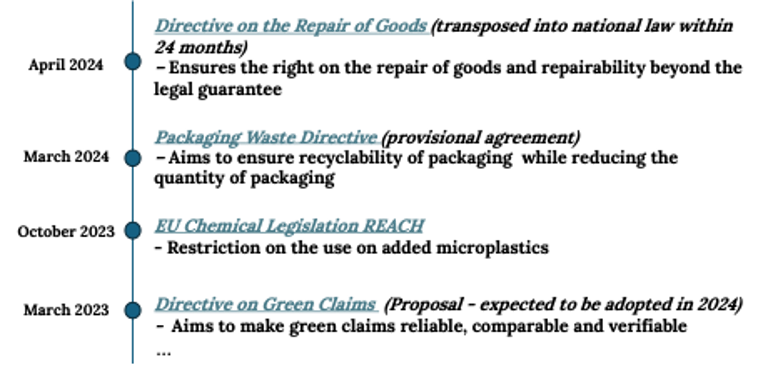In the face of escalating environmental challenges and finite natural resources, businesses around the globe are rethinking their traditional operational models. The linear „take, make, dispose“ approach, which has dominated the industrial landscape for centuries, is increasingly recognized as unsustainable. Enter the circular economy—a transformative concept that promises to redefine how companies operate, innovate, and grow.
In a circular economy, systems and products are designed to eliminate the concept of waste, by enabling the recovery and reuse of all materials at the highest value possible at all times. This paradigm shift not only addresses pressing ecological issues but also presents substantial economic opportunities. For businesses, successfully adopting circular economy practices can result in significant cost savings, new revenue streams, and a competitive edge. This blog post explores the challenges and opportunities associated with circularity, focusing on regulatory compliance, business opportunities, and circularity performance measurement.
Decreasing global circularity levels call for urgent circularity transitions
Despite a surge in discussions, debates, and articles on the circular economy over the past five years, global circularity is in decline. The Circularity Gap Report reveals that the share of secondary materials consumed by the global economy dropped from 9.1% in 2018 to 7.2 % in 2023, a 21 % reduction. Meanwhile, material consumption continues to rise; over the past six years, humanity has consumed more than half a trillion tonnes of materials—almost as much as the entire 20th century. This disparity indicates that current global circularity efforts are failing to keep pace with the overall increase in material consumption. This not only threatens the stability of global ecosystems but also hampers efforts to meet emission reduction targets outlined in the Paris Agreement, given that 45% of global emissions come from industrial, agricultural, and land-use activities that the energy transition alone cannot address. Therefore, enhancing circularity is essential for tackling multiple global sustainability challenges [1].
Increasing circularity legislative requirements
In 2020, the European Commission adopted the Circular Economy Action Plan (CEAP), initiating the introduction of 54 legislative and voluntary measures to advance the circular economy across Europe. These measures address a range of topics, from packaging to the use of critical raw materials among others. Figure 1 highlights some of the recent legislative acts issued under the CEAP. To ensure compliance, businesses must understand these legislative obligations and implement appropriate changes to their business practices.
Additionally, EU reporting requirements outlined in the Corporate Sustainability Reporting Directive (CSRD) and the EU Taxonomy necessitate that businesses specifically report on circularity. The EU Taxonomy mandates reporting on specific circularity measures implemented in certain economic activities, while the CSRD requires businesses to disclose their policies, actions, and targets related to the circular economy if it is a material topic to the company’s business model or value chain. Moreover, the CSRD mandates companies to report on their material inflows and outflows at a company level. While measuring material outflows (waste) is a common KPI in current business operations, tracking material inflows (type, weight, etc.) poses a significant challenge for many businesses.
Realising business opportunities through circularity measures
While businesses must address the legislative requirements established by European and national authorities, they should also focus on the business opportunities inherent in increased circularity. Practices such as extending product lifetimes, reusing, and recovering materials offer significant benefits, including reduced resource dependencies, enhanced resource efficiency, and revenue growth through new business opportunities. A comprehensive study by McKinsey & Company and the Ellen MacArthur Foundation revealed that an extensive implementation of circularity measures across various industries could boost Europe’s resource productivity by 3 percent by 2030, leading to annual cost savings of €600 billion [2]. Similarly, a survey conducted by Bain & Company found that executives expect a 20% increase in the share of revenue from circularity between 2021 and 2030 [3].
To realize these benefits, businesses must rethink how they use materials and strategically integrate circularity into their business models. While integrating circularity principles into current operations can yield benefits through reduced material usage, the true value potential lies in exploring new business models. Such business model adaptations can lead to significant cost reductions, decreased resource dependencies, and the development of circularity-focused business models creating new revenue streams. Examples of these adaptations include as-a-service business models, active material recovery services, and marketplaces for used products. Figure 2 outlines circularity principles captured in the 9R framework and connects them to business model transformation options.

(Circularity principle integration through business model transformation based on 9R framework & The Visionary CEO’s Guide to Sustainability)
Circular Performance Measurement
To successfully manage and track a company’s circularity performance, businesses must establish appropriate performance measurement mechanisms at the company level. This allows for the development of circularity targets with aligned KPIs. Furthermore, effective circularity measurement mechanisms are crucial for meeting the reporting requirements outlined in the CSRD.
Circularity measurement can be conducted on various levels and may include metrics such as material circularity indicators, GHG footprint, resource efficiency, and waste reduction. Numerous organizations, including the Ellen MacArthur Foundation, the World Business Council for Sustainable Development (WBCSD), and Circle Economy, have developed a variety of indicators. Businesses must choose the most suitable indicators from these frameworks to meet their specific circularity management and reporting needs. This currently poses a significant challenge to many businesses as they are yet at the beginning of their circularity journey.

Magnolia Consulting: Your Partner in to successfully implement circularity in your business
At Magnolia Consulting we see the circular economy as an opportunity to create business and environmental benefits at the same time. In our team we combine in-depth knowledge around the circular economy and current sustainability reporting requirements. Moreover, we have experience in the in-depth analysis of companies to identify the most fitting circularity principles along the value chain, enhancing business benefits. To set the cornerstone for a strategic realization of circularity in your business we can support you in selecting fitting circularity measurement frameworks.




